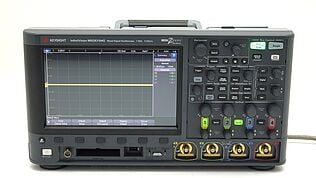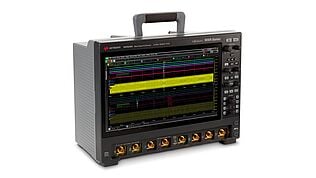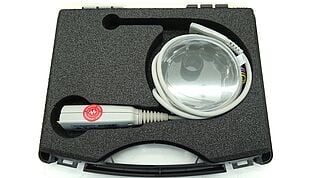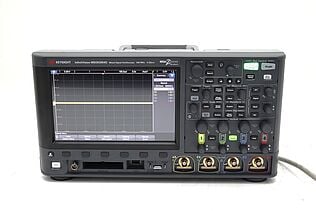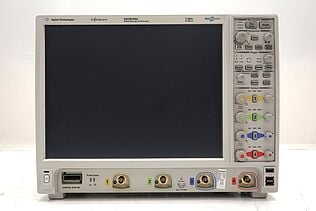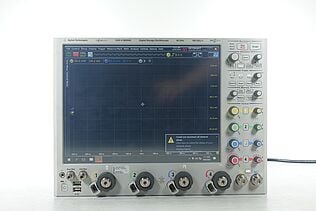- Introduction
- What is Vertical Sensitivity?
- How Vertical Sensitivity Works
- Importance of Correct Vertical Sensitivity
- Adjusting Vertical Sensitivity
- Vertical Sensitivity vs. Other Controls
- Vertical Sensitivity in Digital vs. Analog Oscilloscopes
- Analog Oscilloscopes
- Digital Oscilloscopes
- A Matter of Adjustment
- Vertical Sensitivity and Signal Integrity
- Managing Noise
- Reducing Distortion
- Minimizing Artifacts
- Conclusion
- Whenever You’re Ready, Here Are 5 Ways We Can Help You
Did you know that a mere adjustment of your oscilloscope's vertical sensitivity can mean the difference between a perfectly clear signal and an incomprehensible mess? This seemingly unimportant function holds remarkable significance, and understanding it fully is the key to unlocking the true potential of your device.
Buy Oscilloscopes at a Great Discount
What is Vertical Sensitivity?
Vertical sensitivity in oscilloscopes refers to the ability of the oscilloscope to detect and display changes in voltage on the vertical axis. This is generally expressed in volts per division (V/div), indicating how many volts correspond to each horizontal line on the oscilloscope's grid.
The more sensitive the setting, the more the oscilloscope can "magnify" a signal. This is crucial when dealing with low-voltage signals. Conversely, when dealing with higher voltage signals, a lower sensitivity (higher V/div value) allows the entire signal to be displayed without going off the screen.
| Key Takeaway |
|---|
| Mastering vertical sensitivity in an oscilloscope is essential for accurate and clear signal representation. Correctly adjusting this setting ensures optimal signal resolution, minimizes noise and distortion, and prevents signal clipping, thereby enhancing the overall signal integrity and the quality of your measurements. |
How Vertical Sensitivity Works
When a signal is input into the oscilloscope, it is first processed by the vertical amplifier, which scales the signal based on the vertical sensitivity setting. This amplified (or attenuated) signal is then displayed on the screen.
- With a vertical sensitivity of 1 V/div, a signal of 1V amplitude will span one division on the screen.
- With a sensitivity of 0.1 V/div, the same signal will span ten divisions, filling the entire screen.
Consequently, adjusting the vertical sensitivity helps to better visualize signals of different amplitudes.
Importance of Correct Vertical Sensitivity
Properly adjusting the vertical sensitivity is vital for several reasons.
- Signal resolution: A higher sensitivity (lower V/div) will give a more detailed view of a low-voltage signal, providing better resolution.
- Avoid clipping: If the sensitivity is too high for a given signal, it might exceed the oscilloscope's screen, leading to clipping. This prevents you from seeing the entire waveform.
- Accurate measurements: For correct voltage and timing measurements, the signal must be displayed as clearly as possible on the oscilloscope's screen.
- Noise minimization: Incorrect vertical sensitivity can lead to an over-amplified noise floor, hindering the signal's readability.
Adjusting Vertical Sensitivity
Properly adjusting the vertical sensitivity on an oscilloscope is crucial for obtaining accurate measurements and clear waveform visuals. The following steps provide a general guide on how to do this effectively.
- Connect your signal to the oscilloscope: Begin by connecting the signal that you want to observe to the oscilloscope using an appropriate probe. Ensure that the probe is correctly compensated and matched to the oscilloscope's input impedance.
- Adjust the vertical sensitivity knob or control: Once your signal is connected, use the vertical sensitivity control to adjust the amplitude of the waveform on the screen. Aim to have the waveform occupy a significant part of the vertical screen real estate without causing clipping at the top or bottom. Clipping occurs when the signal exceeds the display range, leading to a loss of data.
- Adjust the vertical position control: With the vertical sensitivity set, use the vertical position control to move the waveform vertically on the screen. This allows for easier visual analysis and ensures you have space above and below the waveform for any signal variations that may occur.
- Use the timebase control: While this isn't directly related to vertical sensitivity, the timebase control adjusts the horizontal scale or sweep speed, affecting how the signal is spread out in time across the display. This can significantly impact the ease of interpreting waveform details, so ensure it's set appropriately for your signal.
Vertical Sensitivity vs. Other Controls
Vertical sensitivity is one of several crucial controls on an oscilloscope. Here's how it compares to some other controls.
| Control | Function | Interaction with Vertical Sensitivity |
|---|---|---|
| Vertical Position | Moves the waveform up or down on the screen. | Does not change the scale of the waveform, unlike vertical sensitivity. |
| Timebase | Adjusts the time scale (s/div) of the display: | Affects the horizontal but not the vertical scale. |
| Trigger Level | Determines the voltage level at which the oscilloscope starts to draw a waveform. | Misaligned trigger and vertical sensitivity levels may cause unstable waveform displays. |
Vertical Sensitivity in Digital vs. Analog Oscilloscopes
While the concept of vertical sensitivity applies to both analog and digital oscilloscopes, the way each type handles it can vary significantly. Understanding these differences is crucial for anyone who works with both types of instruments.
Analog Oscilloscopes
Analog oscilloscopes operate on the principle of deflecting an electron beam across a phosphor screen. Vertical sensitivity in these devices is managed directly through the vertical amplifier. This amplifier scales the signal based on the V/div setting, affecting the vertical deflection of the electron beam and hence the displayed waveform's height.
Digital Oscilloscopes
Unlike their analog counterparts, digital oscilloscopes convert incoming signals to a digital format using an Analog-to-Digital Converter (ADC). The ADC has a fixed number of discrete voltage levels it can represent, called quantization levels. Vertical sensitivity in digital oscilloscopes can be viewed as setting the range of these levels.
The greater the vertical sensitivity (i.e., the smaller the V/div setting), the more the signal is spread across these quantization levels, providing higher resolution. Conversely, with lower sensitivity (larger V/div), fewer quantization levels represent the signal, which can lead to a loss of detail, known as quantization error.
However, one advantage of digital oscilloscopes is that once a signal is digitized, it can be processed, stored, and analyzed without further degradation. This makes them more resilient to noise and distortion once the signal is acquired.
A Matter of Adjustment
Despite the differences in operation, the general rule for setting vertical sensitivity remains the same: adjust it so that the waveform is large enough to see clearly, but not so large that it goes off the screen. Proper adjustment will provide an accurate representation of the signal, whether you're working with an analog or digital oscilloscope.
Vertical Sensitivity and Signal Integrity
Signal integrity is paramount in oscilloscope measurements. It refers to the quality of the signal being measured – that is, the waveform's ability to accurately represent the true signal. Vertical sensitivity plays a significant role in maintaining signal integrity in several ways, including managing noise, reducing distortion, and minimizing artifacts.
Managing Noise
Noise refers to random or inconsistent fluctuations from unknown or unwanted sources that can interfere with your signal, making it difficult to interpret. Too high a vertical sensitivity (low V/div) setting can lead to an over-amplified noise floor, which can obscure small signals or details of a waveform.
On the flip side, too low a vertical sensitivity setting (high V/div) can make noise appear much smaller, potentially hiding issues that should be addressed. Striking the right balance is essential for maintaining signal integrity while effectively managing noise.
Reducing Distortion
Distortion can occur when your oscilloscope's vertical amplifier doesn't linearly amplify the input signal due to incorrect vertical sensitivity settings. This is most likely to occur when the amplitude of the input signal is near the limit of the oscilloscope's range.
Using an appropriate vertical sensitivity setting that matches the signal amplitude ensures a linear response from the amplifier and reduces the potential for distortion. This allows for accurate representation and measurement of the signal
Minimizing Artifacts
Artifacts are components of the waveform that don't represent the actual signal but rather stem from the oscilloscope's processing of the signal. Two examples are aliasing, which happens when the oscilloscope samples too slowly for the signal frequency, and ringing, which can be caused by impedance mismatch or fast signal edges.
While the vertical sensitivity setting doesn't directly cause these artifacts, it does play a role in their visibility. Too high a setting can make small artifacts appear more significant than they truly are, while too low a setting might hide them entirely.
Browse Oscilloscopes at a Great Discount
Select up to 3 instruments to compare
Enable Notifications
In order to use this feature, you need to enable notifications.
Manage notification preferences
Conclusion
Vertical sensitivity is a cornerstone of effective oscilloscope usage, significantly influencing the clarity, resolution, and integrity of the signals you measure. This critical setting determines how your oscilloscope interprets and displays voltage changes, influencing aspects like noise management, distortion reduction, and artifact visibility. Whether working with analog or digital oscilloscopes, understanding and adeptly controlling vertical sensitivity ensures precise and reliable measurements.
For the most accurate measurements you need an oscilloscope that delivers precision, reliability, and superior performance. That's where Keysight's Used Equipment Store comes in. We offer a large selection of quality-tested, premium used oscilloscopes, network analyzers and signal analyzers to meet your diverse testing requirements. Visit the store today and empower your journey towards measurement excellence.

Whenever You’re Ready, Here Are 5 Ways We Can Help You
- Browse our Premium Used Oscilloscopes.
- Call tech support US: +1 800 829-4444
Press #, then 2. Hours: 7 am – 5 pm MT, Mon– Fri - Talk to our sales support team by clicking the icon (bottom right corner) on every offer page
- Create an account to get price alerts and access to exclusive waitlists.
- Talk to your account manager about your specific needs.



